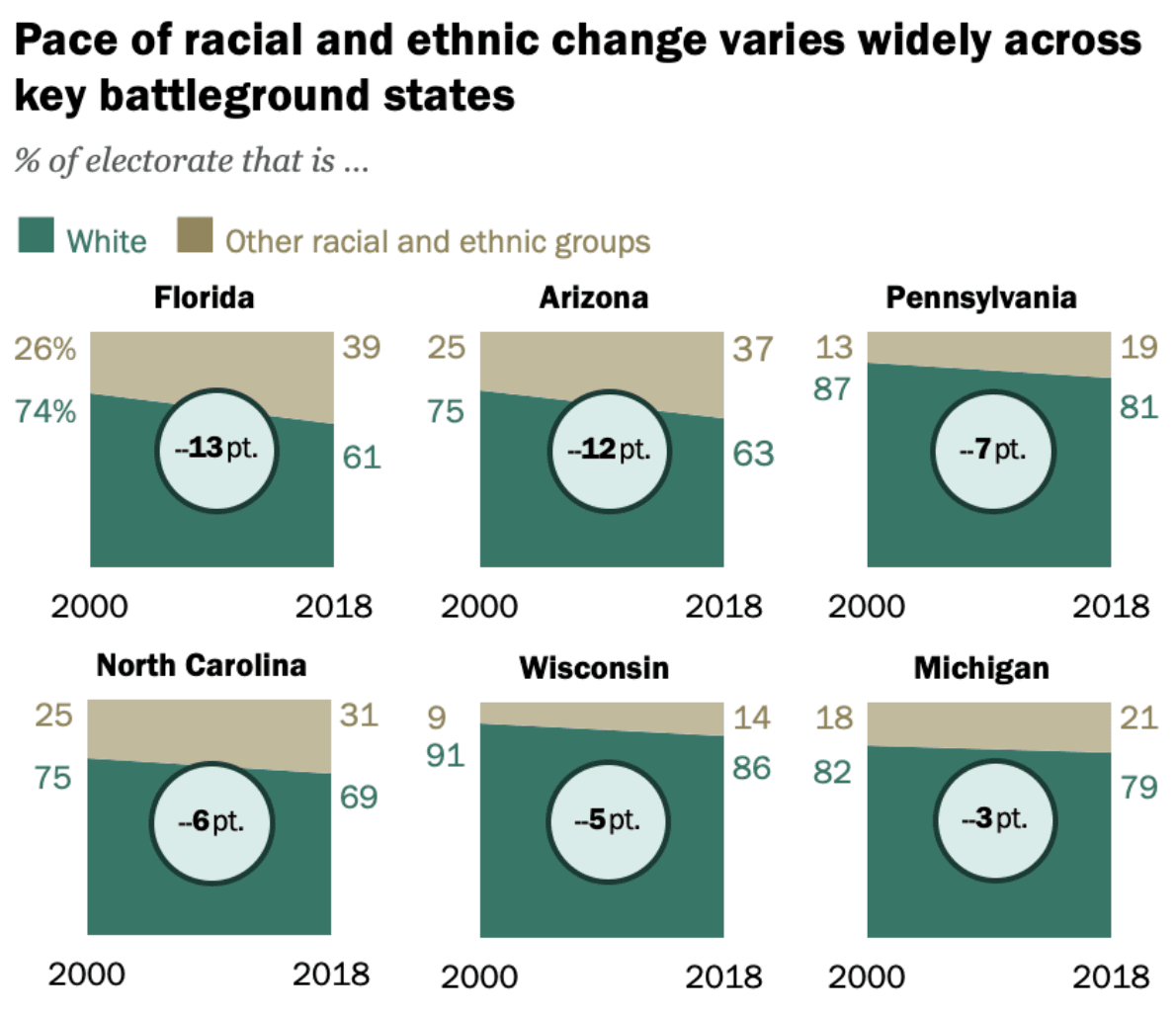Results 1 to 1 of 1
Thread Information
Users Browsing this Thread
There are currently 1 users browsing this thread. (0 members and 1 guests)
-
10-05-2020, 10:45 AM #1
Pew Research: Mass Immigration Drives Up Democrat Support in Swing States
Pew Research: Mass Immigration Drives Up Democrat Support in Swing States
by JOHN BINDER 4 Oct 2020
Mass immigration to the United States is likely driving up support in key swing states as foreign-born voters and the U.S.-born children of immigrants increasingly account for the electorate, a Pew Research Center analysis reveals.
The analysis reviews the rapid demographic shifts of the American electorate compared to nearly 20 years ago. From 2000 to 2018, the share of non-Hispanic white eligible voters has steadily declined from 76 percent to 67 percent.
Oppositely, the share of Hispanics and Asians who make up the electorate has about doubled over the same time period. Hispanics made up seven percent of the electorate in 2000, but in 2018, they spiked to 13 percent. Asians once made up two percent of the electorate and now make up at least four percent.
The Pew researchers say the nation’s annual admission of about 1.2 million foreign nationals is the reason for the demographic shift, an advantage for Democrats:
Pew Research Center survey data spanning more than two decades shows that the Democratic Party maintains a wide and long-standing advantage among Black, Hispanic and Asian American registered voters. Among White voters, the partisan balance has been generally stable over the past decade, with the Republican Party holding a slight advantage.
…
The substantial percentage point increase of voters who are not white as a share of the country’s overall electorate was largely driven by second-generation Americans — the U.S.-born children of immigrants — coming of age, as well as immigrants naturalizing and becoming eligible to vote.
In swing states, the shift is similar. In Florida, the share of non-white eligible voters increased from 26 percent to 39 percenter over the last 18 years. In Arizona, the share of non-white eligible voters increased from 25 to 37 between 2000 to 2018.
Other swing states like Pennsylvania, North Carolina, Wisconsin, and Michigan all saw declines in the share of white eligible voters as part of the electorate and increases ranging from three to seven percent in the share of non-white eligible voters.
 (Screenshot via Pew Research Center)
(Screenshot via Pew Research Center)
The Washington Post, New York Times, the Atlantic, Axios, the Los Angeles Times, and the Wall Street Journal have all admitted that rapid demographic changes because of immigration are tilting the nation toward a permanent Democrat dominance.
“The single biggest threat to Republicans’ long-term viability is demographics,” Axios acknowledged last year. “The numbers simply do not lie … there’s not a single demographic megatrend that favors Republicans.”
If legal immigration levels are not reduced, the U.S. will have imported about 15 million new foreign-born voters by 2040. Those 15 million new foreign-born voters include about eight million who will have arrived through chain migration.
In the upcoming 2020 election, about one-in-ten U.S. voters will have been born outside the country. Likewise, Hispanic Americans are set to outpace black Americans as the largest voting minority group in this year’s election.
Such realities have already been seen in the last presidential election.
Among native-born Americans, Trump won 49 percent to Democrat Hillary Clinton’s 45 percent, according to exit polling data. Among foreign-born residents, Clinton dominated Trump, garnering 64 percent of the immigrant population’s vote compared to Trump’s mere 31 percent.
https://www.breitbart.com/politics/2...-swing-states/Join our efforts to Secure America's Borders and End Illegal Immigration by Joining ALIPAC's E-Mail Alerts network (CLICK HERE)
Similar Threads
-
Poll: Swing State Voters Want Less Immigration amid Mass Unemployment
By Scott-in-FL in forum General DiscussionReplies: 1Last Post: 06-18-2020, 07:44 AM -
Mass Flight From U.S. Labor Force Drives Down April Unemployment
By AirborneSapper7 in forum Other Topics News and IssuesReplies: 2Last Post: 05-02-2014, 09:38 PM -
MASS - Robichaud: Bill drives home high cost of illegals
By Jean in forum illegal immigration News Stories & ReportsReplies: 2Last Post: 02-03-2014, 09:10 PM -
Swing states face immigration fight
By topsecret10 in forum illegal immigration News Stories & ReportsReplies: 2Last Post: 06-13-2011, 07:26 PM -
Swing States May be on the Move - (Healthcare, Immigration)
By Texas2step in forum General DiscussionReplies: 5Last Post: 01-07-2010, 01:03 AM


 LinkBack URL
LinkBack URL About LinkBacks
About LinkBacks




 Reply With Quote
Reply With Quote


Predicted consequences of Biden’s planned invasion, comes to...
04-15-2024, 02:01 PM in General Discussion